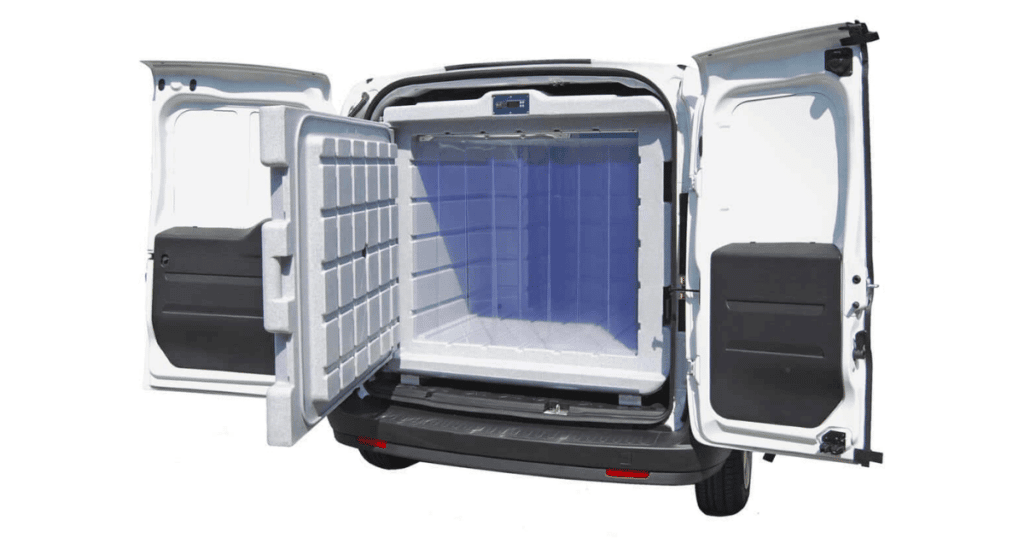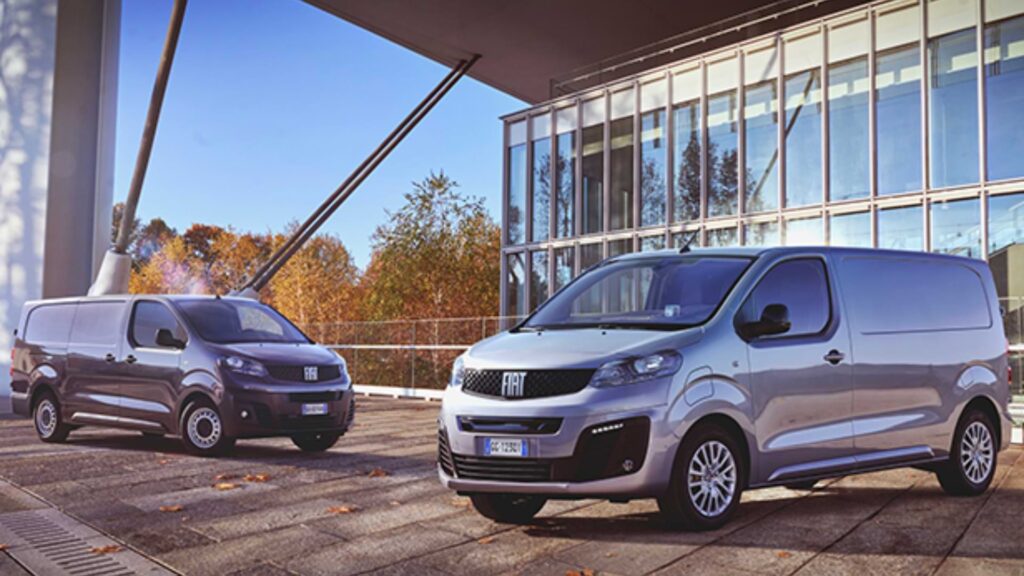What is a refrigerated truck?
A refrigerated truck is a commercial vehicle that has been converted so that the goods transported are kept at a specific temperature, between around -20°C and +12°C. Exclusively designed for professionals and businesses, this type of vehicle is indispensable for the smooth running of florist, catering or frozen food delivery operations.
We'll start by explaining the refrigeration mechanism on a diesel commercial vehicle, to simplify understanding of the transformation to an electric vehicle.
The refrigerated case
Refrigerated trucks are trucks to which an insulated body and a refrigeration unit have been added.
The refrigerated box is an isothermal shell installed in the LCV (light commercial vehicle) to insulate the goods. Its installation results in a slight loss of volume, of less than one cubic meter over the entire load volume.

Refrigerated crates are available in a range of formats to suit the specific requirements of different trades:
- Double storey: with two levels of storage
- Mono temperature: a single temperature zone
- Multi-temperature: different temperature zones using partitions
The refrigeration unit
The refrigeration unit is the equipment used to lower the temperature.
It consists of a thermoregulator: a device that adjusts the temperature, i.e. a thermostat. It operates in two possible ways:
- Via a self-contained auxiliary combustion engine (located behind the driver's cab): diesel-powered.
- Mains-powered (230V)
For internal combustion engines, usually diesel, it is essential to ensure that the vehicle and auxiliary engine are fully fuelled.

How it works
A small control located on the refrigeration unit operates the mechanism.
Once the unit has been switched on and the temperature set, it starts to cool. It takes an average of 90 minutes to reach the desired temperature, depending on the initial and desired temperatures.
It is essential to switch off the thermostat while goods are being loaded, because if the system is still running, refrigerated air escapes and warm, humid air enters.
You need to take great care, because it's a fragile and expensive system.
Is it possible to have a refrigerated electric vehicle?
It's perfectly possible to convert an electric commercial vehicle into a refrigerated one. There are no major differences with a refrigerated internal combustion engine vehicle. In fact, the process of transforming the vehicle into a refrigerated one is the same. All that needs to be added is a second battery to power the refrigeration unit.
The fitting must be carried out by a company specializing in fitting refrigerated vehicles. Fitting must be carried out after the vehicle has been purchased. If you want to fit out a vehicle you're leasing, be sure to keep the lessor informed of your plans. He may refuse to fit out the vehicle, as it would be too expensive to restore it to normal once it has been returned. Or they may charge you additional fees precisely in anticipation of the time when you will return the vehicle.

What impact will the refrigeration system have on your electric vehicle?
To install the refrigeration option on your electric vehicle, you'll need to add a second battery to your vehicle, which will be used solely to power the refrigeration unit.
This second battery, like the refrigeration system, will add considerable weight to your vehicle. As your vehicle is heavier, itsrange will be reduced by 30 to 40% of the total range.
And don't forget that fitting out a refrigerated vehicle comes at a price. Depending on the model and the supplier, you can expect to pay between €10 and €18,000 to fit out your electric refrigerated van.
When is an electric refrigerated vehicle the right choice for me?
This type of vehicle is essential for transporting goods that need to be kept cool at all times.
If you're looking for this type of electric vehicle, you should be aware that it won't meet all your needs.
This type of vehicle is best suited to your needs if you make short journeys and sometimes find yourself parked for long periods. You'll be able to set up close to a charging station, so you can go about your business while recharging your vehicle. You won't have to think about your range to get your vehicle back to the garage, and you'll be able to keep your vehicle refrigerated at all times.
For your convenience, choose a vehicle that charges quickly over one with a longer range. The ratio of range recovered by recharging to additional range will generally not be advantageous for the vehicle with the best range. Of course, if you have the opportunity to purchase a vehicle with a better range and faster recharging speed, don't deprive yourself.
In general, a refrigerated box is 17 m³, so choose a vehicle with enough space to accommodate at least one box of this size.
Read also:
In a nutshell
Refrigerated and electric vehicles are perfectly compatible. The mechanism applied to internal combustion vehicles has been adapted, so that low-emission vehicles remain non-polluting vehicles.
In addition to successful adaptation, the alternative of an electric refrigerated vehicle is also possible. It is possible to replace a diesel refrigerated vehicle with an electric one. The needs of business use are covered. An opportunity to be seized if travel is restricted to a small radius.
































